12 Xeriscape Ideas for Drought-Tolerant Landscaping
Your dry location doesn’t limit you to just dead grass or a yard full of gravel


Whether you live in an arid climate or simply want to trim your environmental footprint, you can have a thriving and even colorful landscape that requires minimal water. Xeriscaping is a form of energy-efficient landscaping that features native drought-tolerant plants, proper drainage, and turf alternatives. Take a look at these 12 xeriscape ideas that will have you rethinking your grassy yard and significantly help you conserve water outdoors.
1. Play With Cacti Height
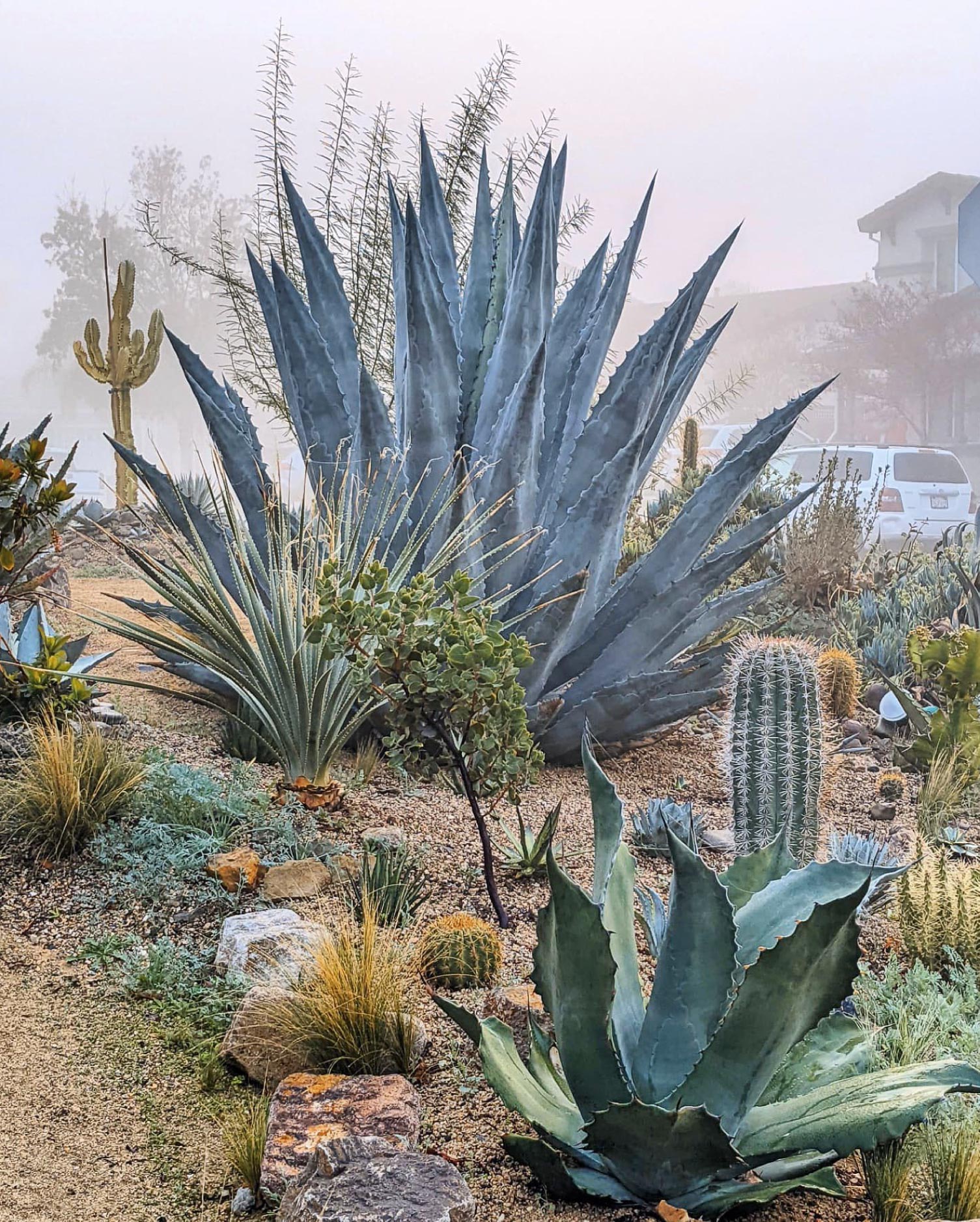
A variety of cacti at varying heights creates a blue-green sea in this low-water backyard design. The differing heights help move the eyes around the landscape, despite the plants being similar colors. Anchored by rocks rather than grass, the area needs little water, yet it looks lush in its California desert location.
And while xeriscaping prices for a full front lawn like this average between $11,000 and $15,000, the amount of money saved on water and time on maintenance is key.
2. Save With Artificial Turf

The trick to balancing landscaping costs often comes down to determining upfront prices compared to long-term maintenance costs. Artificial turf is a major player in most xeriscaping ideas since it requires absolutely no water to thrive. In this backyard, the artificial turf surrounds a naturally thriving garden packed with colorful native plantings while also making room for a stone walkway. In addition to using far less water during installation, maintaining artificial turf is simple.
3. Make the Most of Mulch
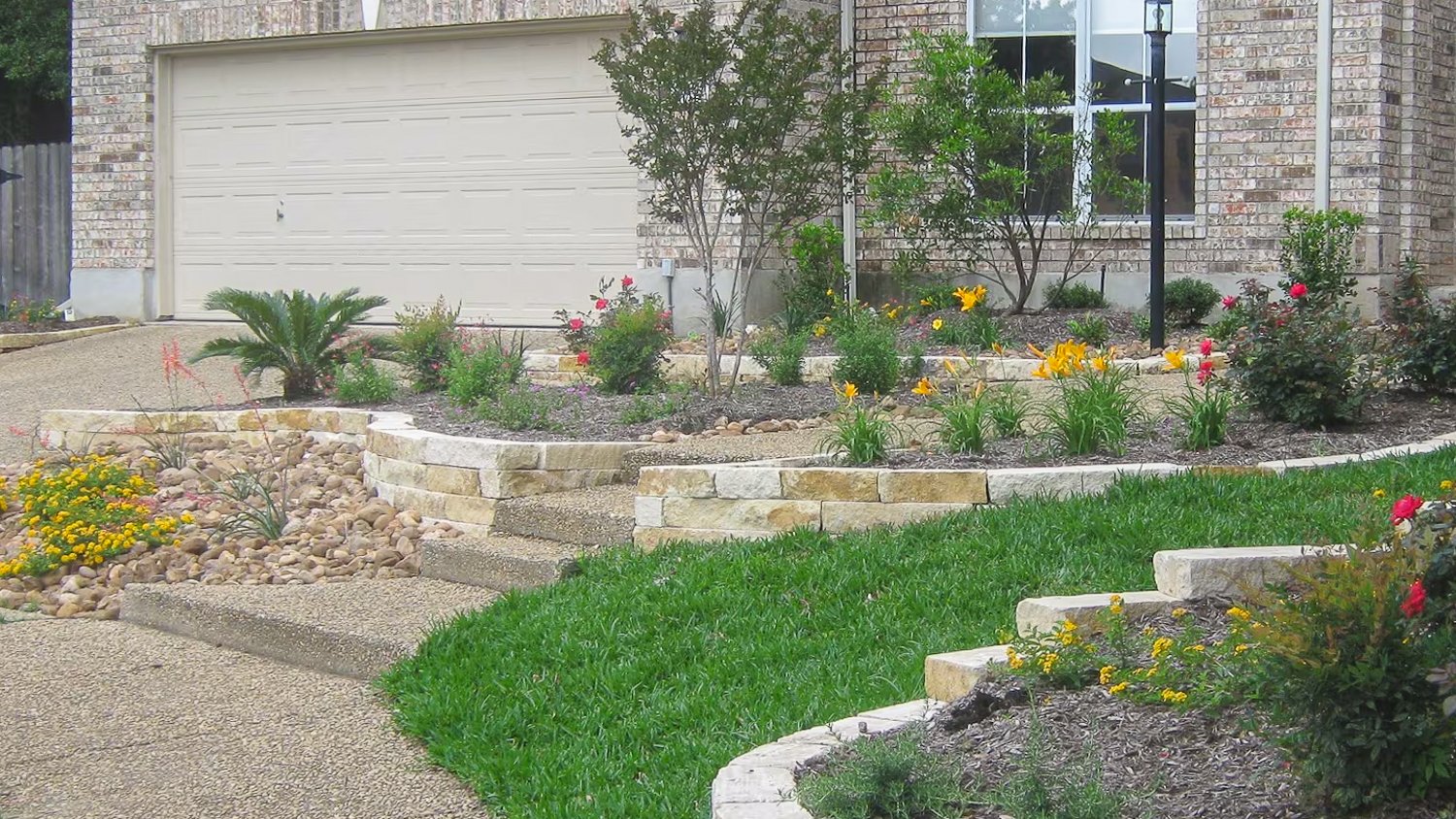
Did you know that gardening with mulch is one of the top ways to hold in moisture and insulate the ground from extreme changes? Make the little water you need for your garden go a long way by laying down organic mulch. Examples include wood chips, leaves, grass clippings, straw, bark, or compost. Mulch is helpful throughout the country, but it is also particularly helpful in areas that do not support drought-tolerant plants such as succulents and cacti.
4. Be Bold With Color
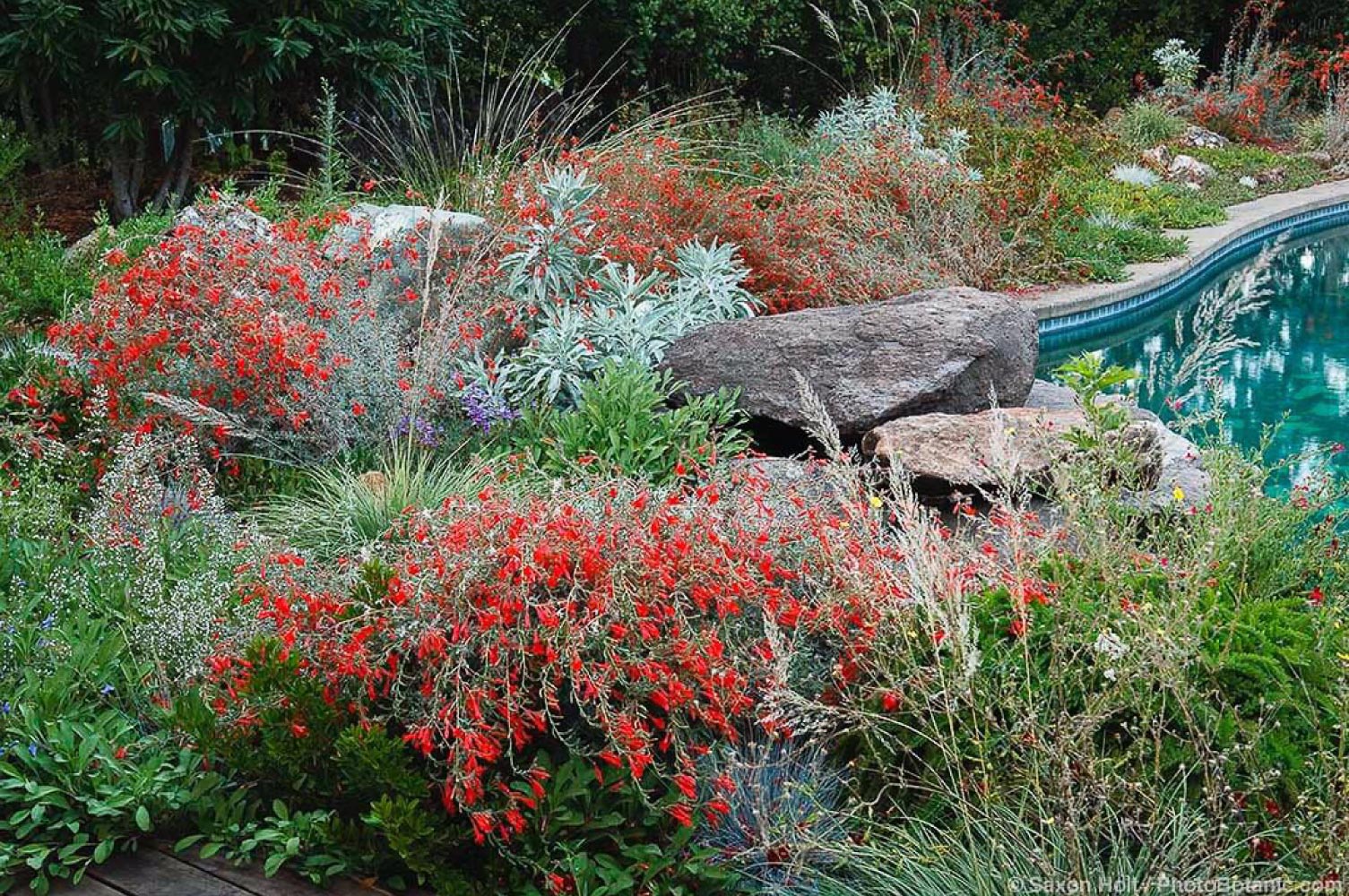
When you think of low-water backyard designs, images of green succulents or yards full of rocks might come to mind. While we’ve seen that cacti and succulents can make a landscape look lush, you can also achieve a colorful haven that even attracts pollinators. Here, California fuchsia, a willow herb native to California, adds pops of red and is popular with hummingbirds. Salvia brings in hints of purple, and native grasses create a contrasting green backdrop without the need for frequent watering than conventional grass lawns have.
5. Embrace the Rock Garden
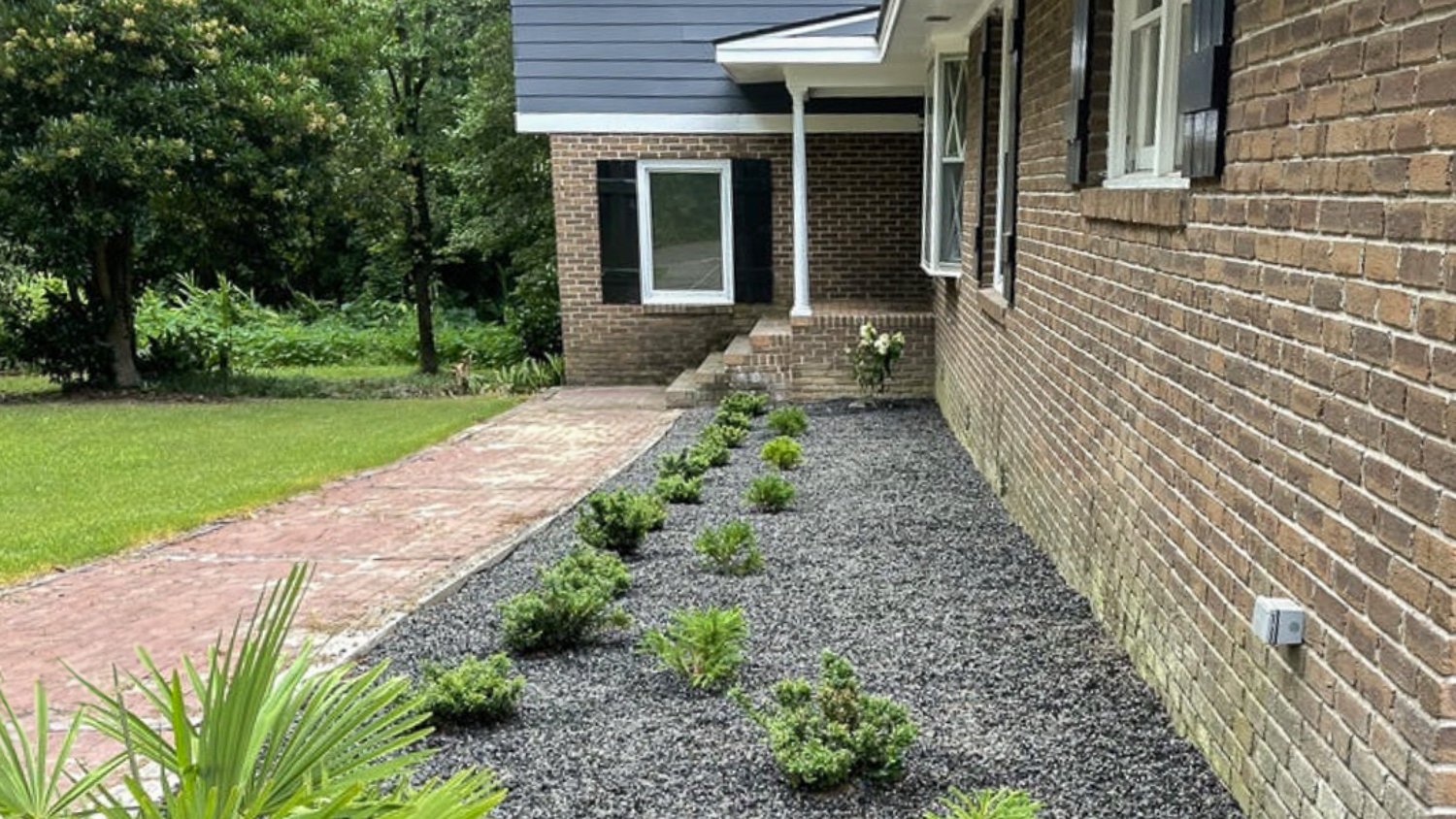
There are several perks to choosing one of our rock garden ideas at your fingertips. Rocks act as an inorganic mulch that prevents erosion and helps rainwater naturally filter into the ground. They also replace water-dependent ground cover plants that would usually surround your home. What's more, surrounding your home with rocks can cut down on mold growth and water pooling around your foundation. Last but not least, rock gardens typically cost less, particularly when considering the cost of river rocks as pictured above.
6. Create an Eye-Catching Landscape

For this project, a client commissioned Twice the Style, Inc. to design a landscape that will make people stop and smell the succulents. “This is one of my favorite projects, precisely because it is a real low-maintenance garden, done with native plants and drought-resistant ones,” says Natalie Marshall, founder of Twice The Style, Inc.
A short, leafy Canary Island date palm tree serves as the focal point, complementing other green, drought-resistant plants. And the purple flowers on the New River bougainvilleas pop against the yellow home.
7. Peruse Paver Options
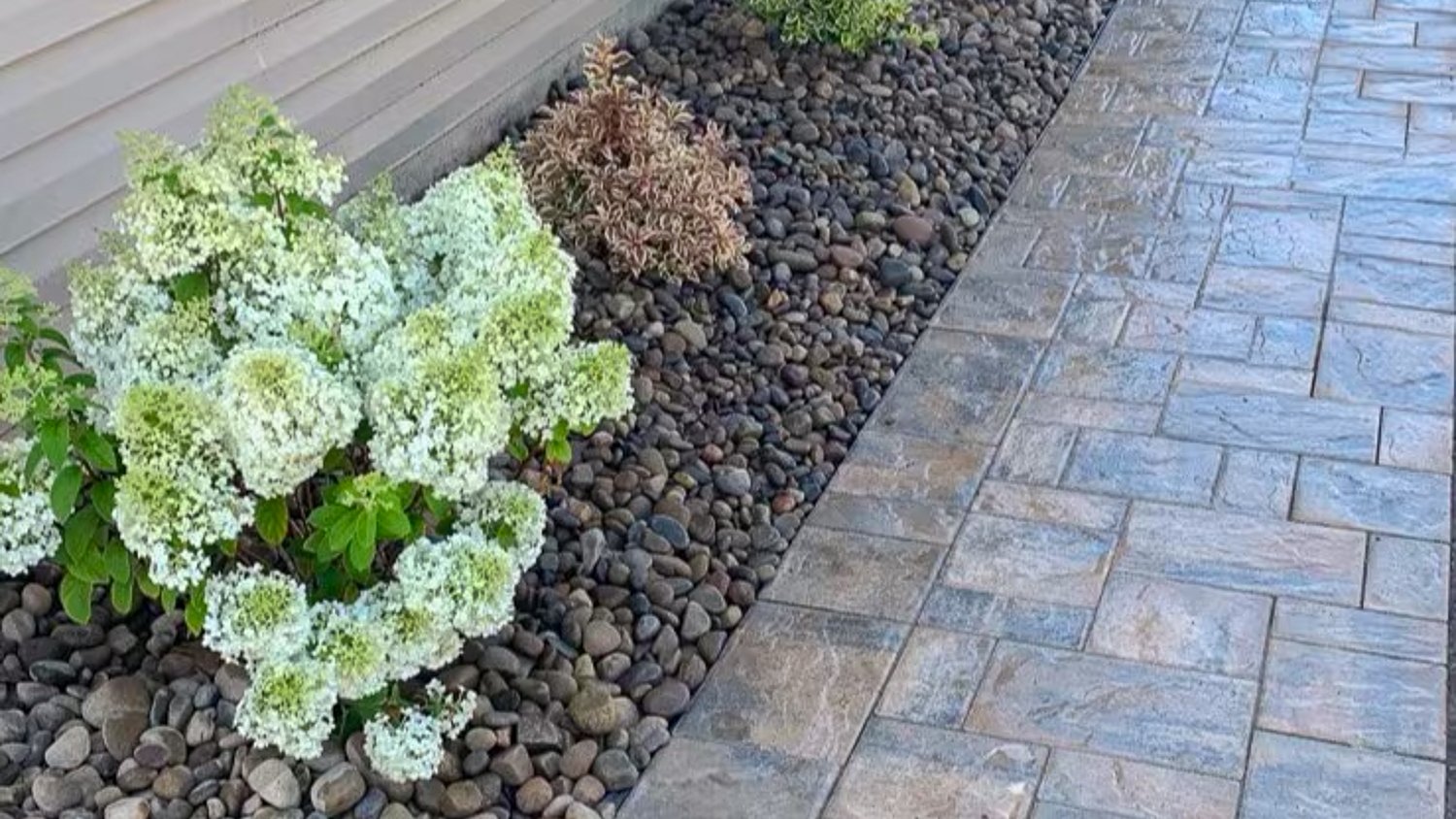
While adding pavers to your landscape certainly cuts down on how much you need to water, go a step further with pavers optimized for rainfall. Permeable pavers and pavers with drainage solutions can help redirect water properly into the ground, mobilizing how much you need to break out the hose for the surrounding landscape. It’s also ideal for high-traffic areas such as walkways and driveways.
8. Design for Steep Slopes

Xeriscaping is not just about adding drought-happy plants. Guiding the flow of water you need to irrigate your garden is just as important. Work with a contractor to consider one or more retaining walls for your lawn when working with an uneven or consistently steep slope. As this lawn highlights, retaining walls are another great example of rock landscaping ideas. Locally sourced boulders offer a more natural look to your wall while still assisting with drainage and irrigation.
9. Edge Out Weeds With Native Plants
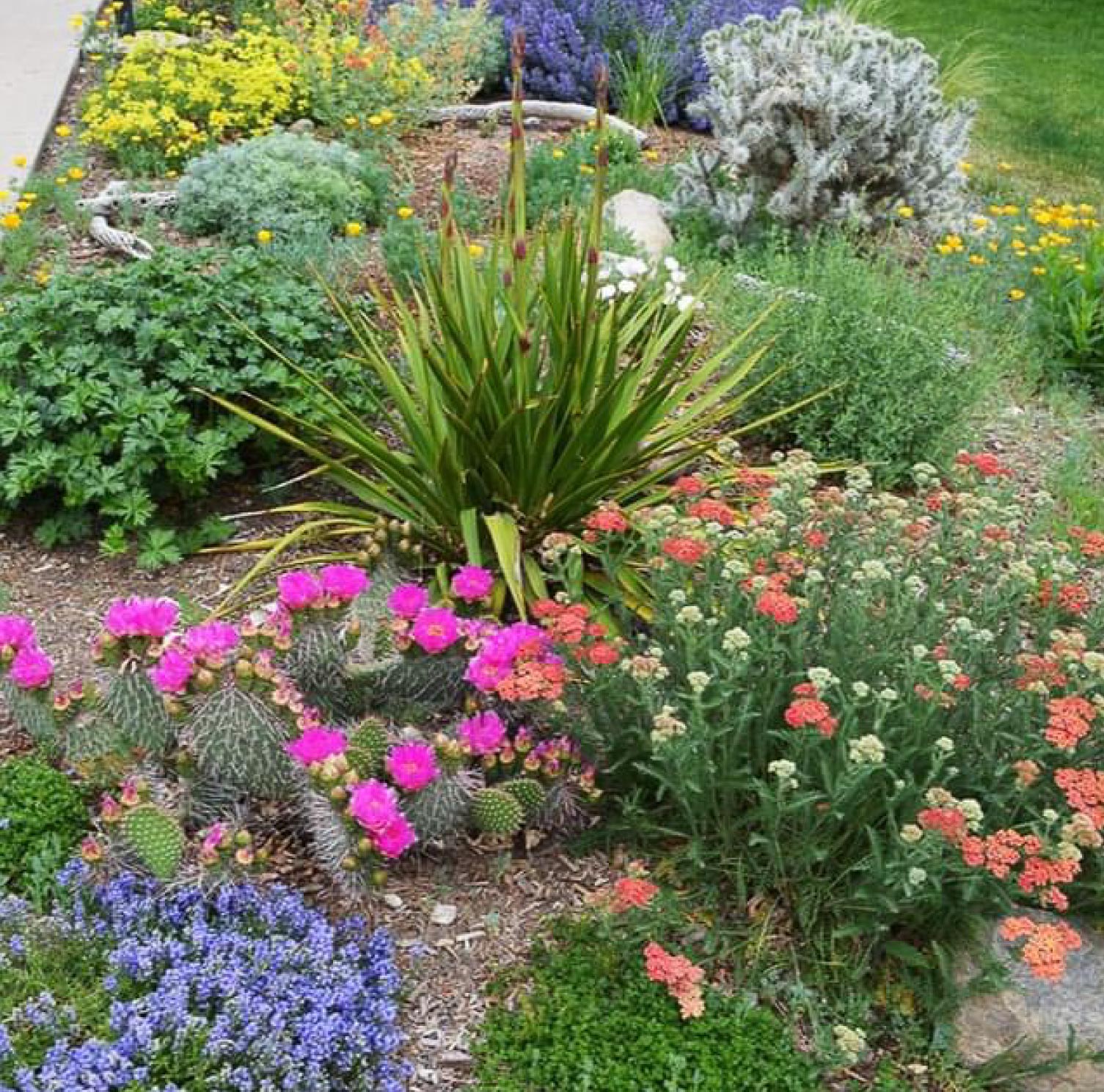
This xeriscape backyard design naturally fights off weeds—and does so in style. Local plants with purple, red, blue, and yellow flowers bring in a lot of color alongside the greens of the cacti and native grasses. You or a local landscaping pro should plant them close together because according to Outdoor Design Group, this arrangement is better at preventing weeds than filling an area with gravel.
10. Confine Your Cacti
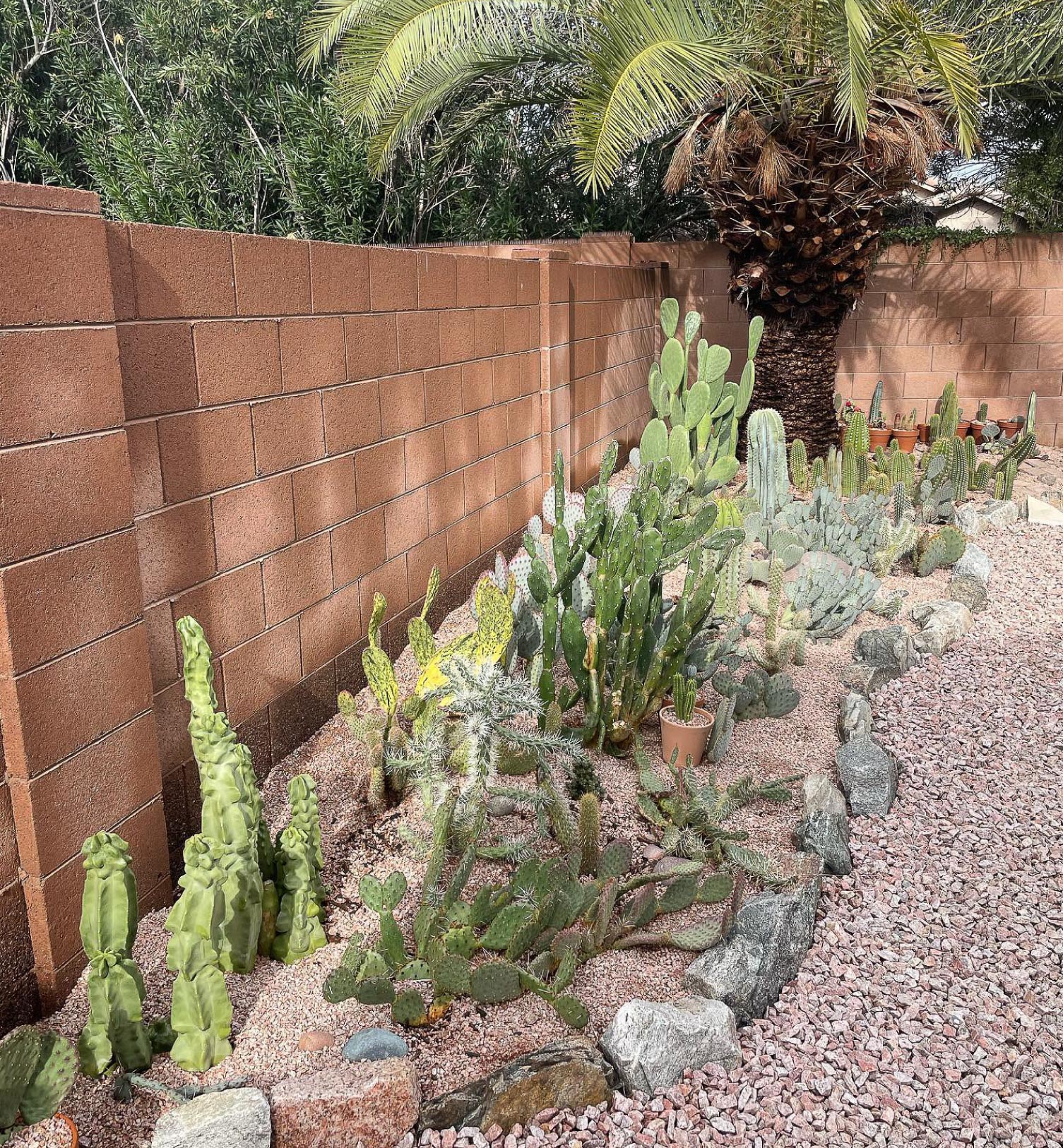
Many people designate certain spots of their yard for flower or vegetable gardens. In a dry climate, why not confine drought-resistant plants within a specific area instead? As a kid growing up in the Midwest, hobby gardener Juan Gonzalez used to tend to vegetable and flower gardens. Then, Gonzalez relocated to Arizona in 2015 for work and found that growing these plants was more challenging.
“Rather than continuing to struggle with plants that require a lot of irrigation, I decided to try a style of landscape requiring little or no irrigation and using plants that are native to arid regions: cacti,” says Gonzalez. “Growing cacti quickly became a hobby, and some would even call it an obsession of mine. I now have hundreds of cacti as part of my collection.”
11. Make the Most of a Small Space
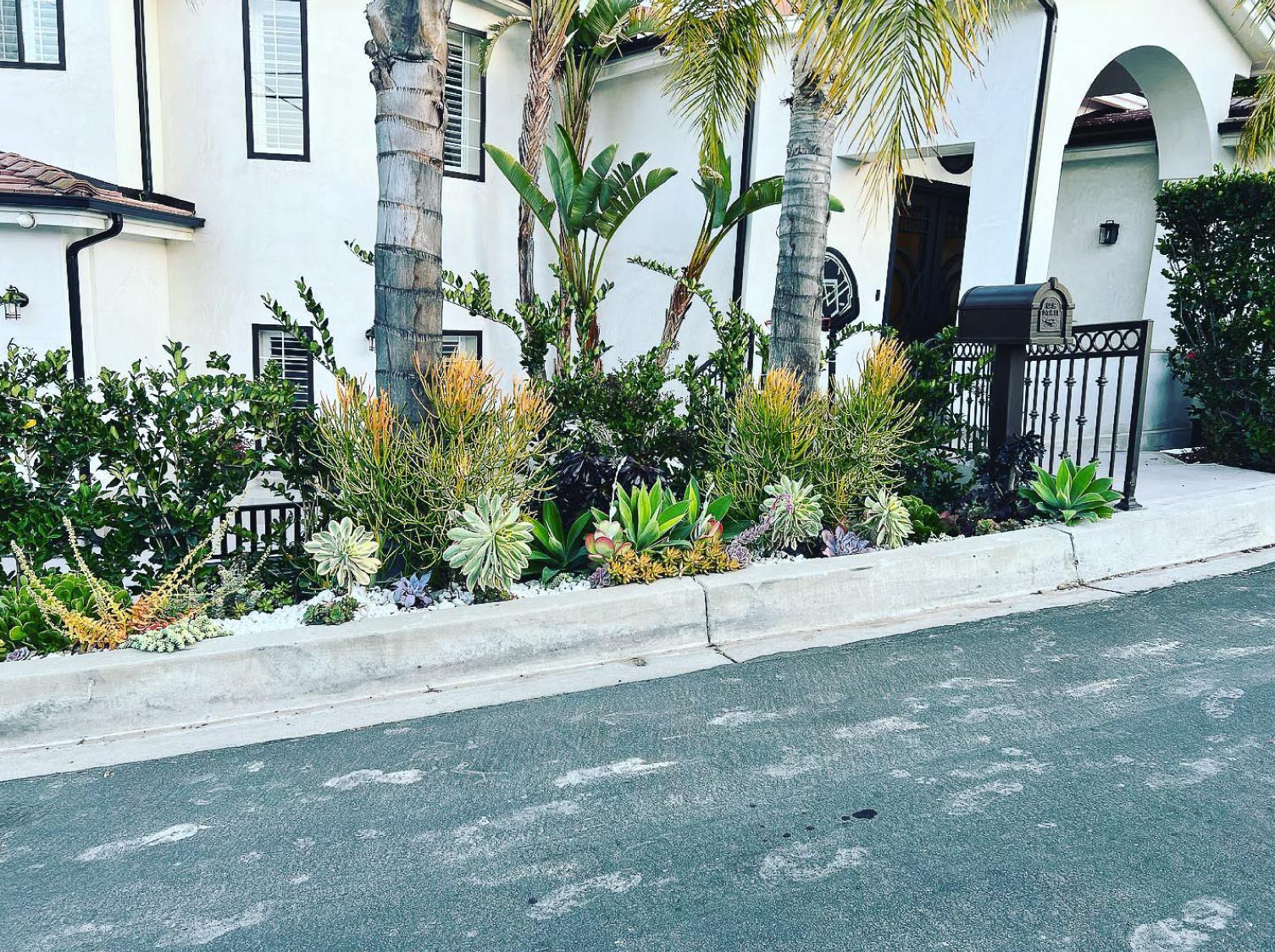
Like creating a low-water garden in a designated space, you can also turn even the most narrow or smallest landscapes into plant-filled oases. This property offers minimal space for planting. Rather than fill it with just rocks or a few cacti, the designers at Elm Tree Living packed a punch with several types of native plants and trees in a narrow planter.
Against the white house, the plants become the main attraction despite the landscape’s small footprint. That’s why it’s key to consider landscape design plans when updating your home; the landscape is the first thing you, guests, and passersby will see of your home every day.
12. Design Livable Spaces
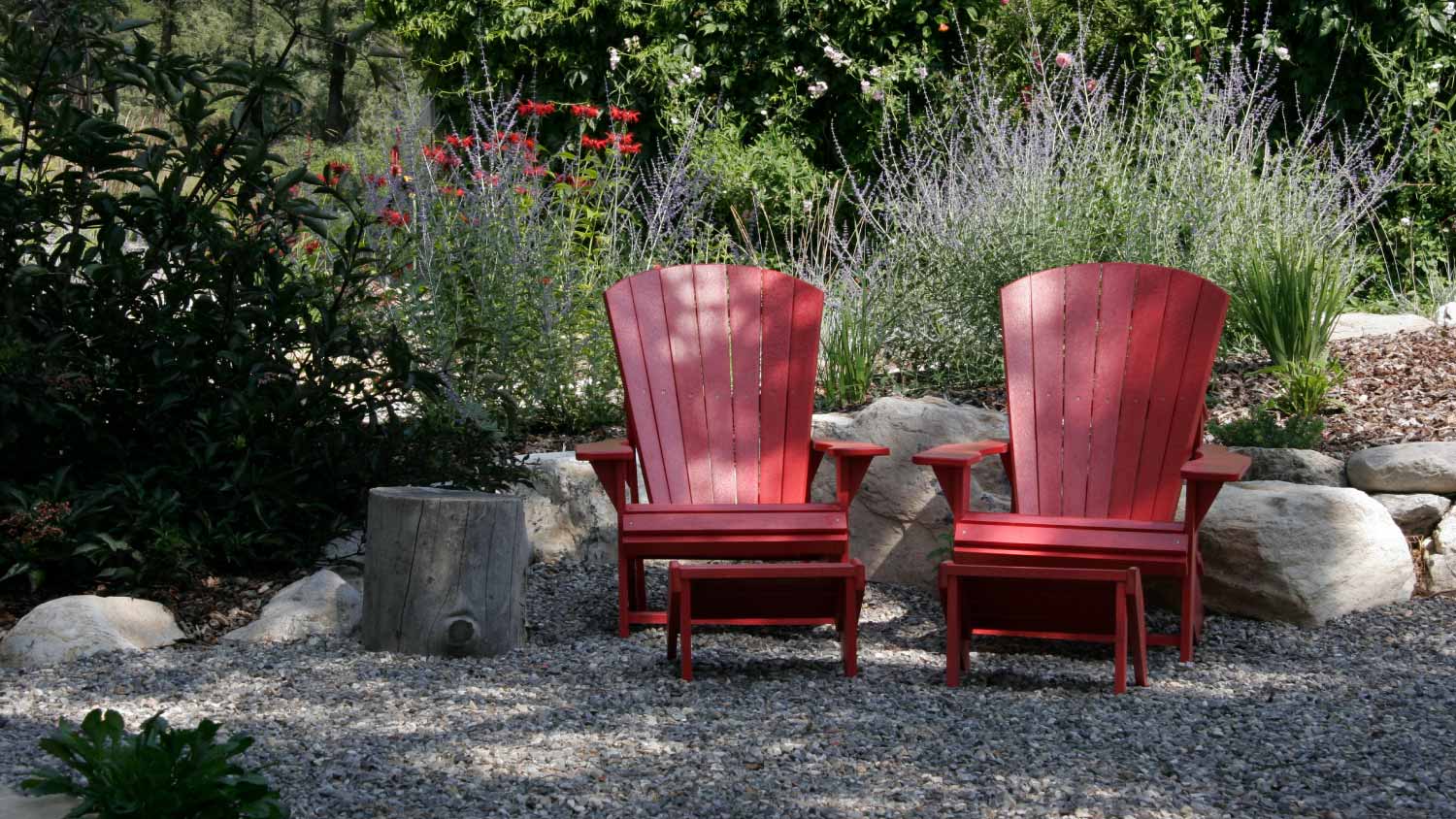
Consider the cozy opportunities when filling your garden with hardy plants that thrive with minimal moisture. The increase in stone or paved space means more chances to create outdoor lounging and dining areas. Include seating in an area with equal parts sun and shade throughout the day, particularly to take in the beauty of your rock and cacti garden. Outdoor family rooms require minimal maintenance to make it the new favorite place on your property.
Paige Bennett contributed to this piece.





- Landscapers
- Tree Surgeons
- Gardening Services
- Landscape Architects
- Sod Installation
- Tennis Court Contractors
- Landscape Design
- Retaining Wall Companies
- Grading Companies
- Landscape Rock & Sand Delivery
- Mulch Delivery Services
- Pond Companies
- Artificial Grass Companies
- Shrub Removal & Trimming
- Backyard Design Companies
- Commercial Landscaping
- Koi Pond Services
- Backyard Landscapers
- Trampoline Assembly
- Hedge Trimming
- Pond Services
- Garden Design
- Outdoor Plant Watering
- Putting Greens
- French Drains
- Turf Installation
- Sod Removal Services
- Lawn Repair Services
- Brush Chipping Services
- Hardscape Contractor
- Landscape Rock Removal
- 18 Low-Maintenance Landscaping Ideas
- What Is Xeriscaping, and How Can You Do It Successfully?
- 47 Landscaping Ideas to Consider for Your Home
- 13 Genius Low-Maintenance Front Yard Landscaping Ideas
- 41 Backyard Landscaping Ideas for Next-Level Outdoor Living
- 9 Garden Styles to Inspire Your Outdoor Sanctuary
- 21 Front Yard Landscaping Ideas to Boost Your Curb Appeal
- 7 Types of Landscaping Styles for Your Yard
- How to Spruce Up Your Existing Garden by Adding New Plants
- Make a Splash With These 8 Outdoor Water Conservation Tips










